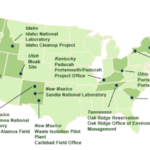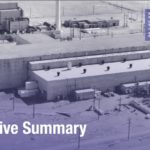
Federal Facilities Task Force
America’s nuclear weapons complex, developed during World War II and expanded throughout the Cold War, created a significant environmental cleanup legacy that spanned 107 sites and 35 states and will require decades to complete. To provide ongoing technical assistance to states and facilitate coordination with the U.S. Department of Energy, the NGA Center for Best Practices convenes the Federal Facilities Task Force. This network of governors’ designees from states hosting or affected by ongoing federal cleanup sites continues to play an active role ensuring safe, cost-effective, and thorough federal cleanup of defense nuclear waste through ongoing coordination with DOE, robust interstate collaboration, regular meetings, and engagement with other state, local, tribal, and federal groups.
The NGA Center for Best Practices established the Federal Facilities Task Force (FFTF) in 1993 to assist in the development of the initial Federal Facilities Compliance Act site treatment plans. The FFTF continues to support state efforts. The mission of the FFTF is to bring together governor-designated representatives with U.S. Department of Energy (DOE) officials to examine critical technical, policy and budget issues and improve coordination of major program decisions on a range of issues related to radioactive material and waste, including:
- Transparency in the DOE decision-making process, particularly for waste treatment and disposal decisions.
- A safe transportation and disposal system for all types of radioactive waste.
- Sufficient funding for DOE to meet annual milestones in state-DOE compliance agreements.
- Long-term stewardship at sites where cleanup to unrestricted levels is not possible.
Principles of the Federal Facilities Task Force
The FFTF, in consultation with DOE, developed a set of principles to guide how state regulators and DOE jointly approach planning and prioritization of cleanup work.
- States support a sustained, quality cleanup that protects human health, safety, and the environment and complies with state-DOE agreements.
- Open and transparent communication between states and DOE is essential for achieving successful cleanup.
- State participation is a critical element of the DOE budget process and establishment of environmental priorities.
- States support a “risk plus other factors” approach to priority-setting, as defined in the Final Report of the Federal Facilities Environmental Restoration Dialogue Committee.
- Proactive engagement between DOE and states is crucial when cleanup milestones or other commitments may be in jeopardy.
FFTF Membership
Governors of each participating state designate up to two representatives to serve on the FFTF. Appointments typically include one policy and one technical or regulatory representative, but these selections are at the discretion of each governor. Representatives usually come from one or more state agencies responsible for the oversight and regulation of hazardous waste, such as environmental protection, energy, or natural resources departments.
The 13 states currently participating in the FFTF, are: California, Idaho, Kentucky, Missouri, Nevada, New Mexico, New York, Ohio, Oregon, South Carolina, Tennessee, Texas, and Washington.
This map shows the remaining major cleanup sites and highlights states that are members of the FFTF. Also included are DOE’s estimated completion dates for final closure of each site. Missouri, Texas and Oregon do not have active cleanup sites run by DOE EM but are members of the FFTF because of their proximity to other DOE EM cleanup sites and because they engage in activities relevant to the group. Sites not shown on the map include Brookhaven National Laboratory and the Separations Process Research Unit in New York, the Energy Technology Engineering Center and Lawrence Livermore National Laboratory in California and the Moab Uranium Mill Tailings Remedial Action project in Utah.
Publications

Ensuring Clarity and Transparency in Radioactive Waste Definitions

Cleaning Up America’s Nuclear Weapons Complex: 2023 Update for Governors

Cleaning Up America’s Nuclear Weapons Complex: 2019 Update for Governors

Setting Site-Specific Priorities in the Federal Budget Process for Cleanup of Nuclear Weapons Waste: Opportunities for State Engagement
Cleaning Up America’s Nuclear Weapons Complex: 2015 Update for Governors
Meetings & Webinars

Twenty-First Annual Intergovernmental Meeting on Nuclear Weapons Waste Cleanup

Spring 2022 Meeting of Federal Facilities Task Force

Relationships and Roles within Regulatory Frameworks for Nuclear Waste Cleanup

2021 Spring Meeting of the Federal Facilities Task Force

2021 Winter Meeting of the Federal Facilities Task Force

Nineteenth Annual Intergovernmental Meeting with the U.S. Department of Energy on Nuclear Weapons Waste Cleanup


